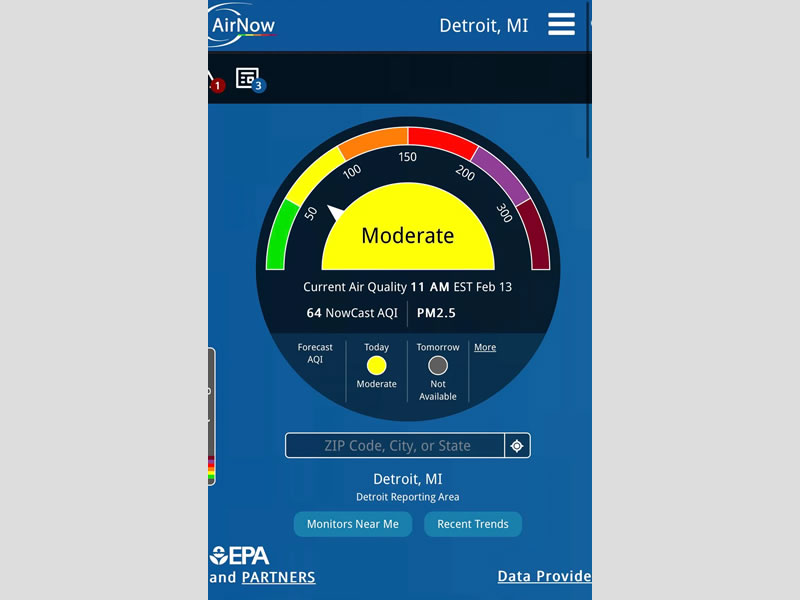
I am always recommending https://www.airnow.gov/ to my allergy, asthma and COPD patients because polluted air can cause symptoms that resemble allergies and can cause worsening of asthma and COPD. Airnow.gov measures ozone and several sizes of volatile organic chemicals that are representative of the overall air quality. Ozone is a very reactive molecule that can damage lungs, leading to worsening of lung disease and long-term, can cause cancer. Hot, summer days tend to have higher ozone levels. The pollution generated by cars and factories increases the volatile organic chemical level. Taken together, they add up to the air quality index (AQI), which gives an overall idea of how good or how bad the air is.
This is the description of precautions you should take if the AQI starts degrading:
Let’s start at the beginning. Once you get the app, open it up. The first thing you may notice in the upper left corner is an alert. Click on that and see what you get.
The day I tried it, it showed Volcanic eruptions in Hawaii! This has got to be the first time I am glad I’m not in Hawaii.
Enter you zip code or city into the blank provided, and you will come up with the current air quality index value and the breakdown of ozone and volatile organic chemicals in the air. The nice aspect of this breakdown is that if you are more sensitive to one or the other, you will find out if you study it. It is important to mention that this is updated regularly so you may find your area is green (great) in the morning but during rush hour, the AQI gets bad.
Look farther down on the app and you will see that you can look at the air quality throughout the world, through participating embassies and consulates; look at historical data by reviewing archived dates; look at the webcams throughout the country; find out who is participating in the air quality flag program (posting of flags that correspond to air quality); have alerts sent to your email; or see current fire data for your area or around the country. This feature, “Current Fire Conditions” is very useful because fire greatly affects the air quality. I advise my patients with sensitive lungs to review this before they takes trips around the United States, just so they can stay out of areas with fire and therefore smoke.
How should you respond? The guide to what you should do (for example, limit your time outside), is found by moving your cursor over the color in the center of the AQI dial or you can review the AQI legend to the left of the AQI dial. You are a “sensitive group” if you have lung disease, asthma, COPD, pulmonary fibrosis, or any other chronic issue of the lung. If there is a question, ask your doctor if you are in one of the “sensitive groups”.
If you think you may have breathing issues, know you have asthma, want a breathing test, allergy test, allergy shots, or just want to take better care of yourself, call us now for an appointment. Dr. Wendt and her team staff at Relieve Allergy, Asthma & Hives would love to help.
Relieve Allergy Asthma & Hives is located near Kierland Commons, Scottsdale Quarter, DC Ranch and Grayhawk at 21803 N. Scottsdale Road Ste. 200, on the corners of Deer Valley and Scottsdale Roads, and has convenient evening and early morning hours to accommodate your schedule.
Dr. Wendt is also available for telemedicine appointments as appropriate. Insurance plans accepted. Call 480-500-1902 today to schedule an appointment now and begin your allergy testing and treatment with Dr. Wendt at Relieve Allergy, Asthma & Hives in Scottsdale, Arizona.
Learn more about Dr. Wendt and Relieve Allergy Asthma & Hives at www.relieveallergyaz.com and FOLLOW US on Instagram, Twitter, Facebook and Linked In.
Subscribe to our new YouTube channel or TikTok site for demonstrations on proper use of allergy and asthma devices, video education, and Dr. Wendt’s news interviews.
Share this post. Choose your platform:
Search Blog & Pages
Recent Posts

